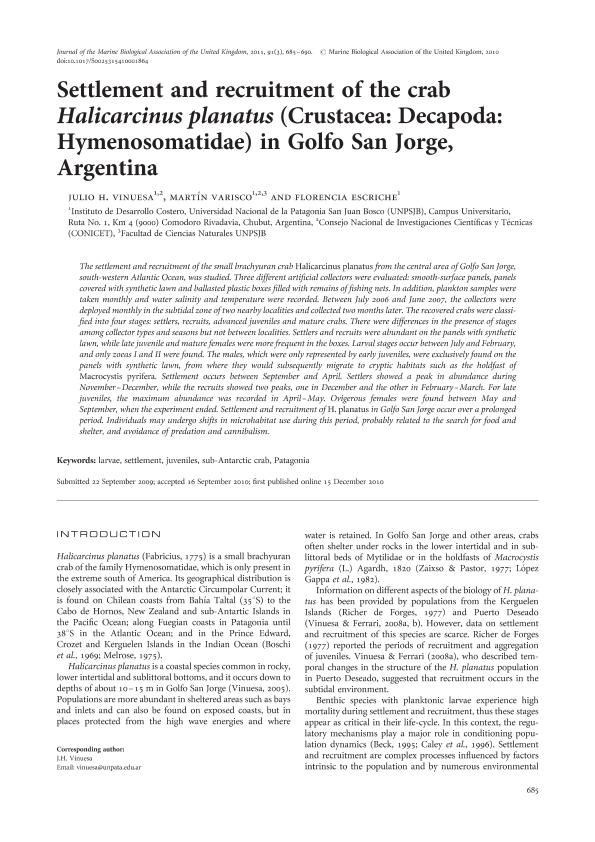Mostrar el registro sencillo del ítem
dc.contributor.author
Vinuesa, Julio Hector

dc.contributor.author
Varisco, Martin Alejandro

dc.contributor.author
Escriche, Florencia

dc.date.available
2023-03-29T11:07:58Z
dc.date.issued
2011-05
dc.identifier.citation
Vinuesa, Julio Hector; Varisco, Martin Alejandro; Escriche, Florencia; Settlement and recruitment of the crab Halicarcinus planatus (Crustacea: Decapoda: Hymenosomatidae) in Golfo San Jorge, Argentina; Cambridge University Press; Journal of the Marine Biological Association of the United Kingdom; 91; 3; 5-2011; 685-690
dc.identifier.issn
0025-3154
dc.identifier.uri
http://hdl.handle.net/11336/191926
dc.description.abstract
The settlement and recruitment of the small brachyuran crab Halicarcinus planatus from the central area of Golfo San Jorge, south-western Atlantic Ocean, was studied. Three different artificial collectors were evaluated: smooth-surface panels, panels covered with synthetic lawn and ballasted plastic boxes filled with remains of fishing nets. In addition, plankton samples were taken monthly and water salinity and temperature were recorded. Between July 2006 and June 2007, the collectors were deployed monthly in the subtidal zone of two nearby localities and collected two months later. The recovered crabs were classified into four stages: settlers, recruits, advanced juveniles and mature crabs. There were differences in the presence of stages among collector types and seasons but not between localities. Settlers and recruits were abundant on the panels with synthetic lawn, while late juvenile and mature females were more frequent in the boxes. Larval stages occur between July and February, and only zoeas I and II were found. The males, which were only represented by early juveniles, were exclusively found on the panels with synthetic lawn, from where they would subsequently migrate to cryptic habitats such as the holdfast of Macrocystis pyrifera. Settlement occurs between September and April. Settlers showed a peak in abundance during November-December, while the recruits showed two peaks, one in December and the other in February-March. For late juveniles, the maximum abundance was recorded in April-May. Ovigerous females were found between May and September, when the experiment ended. Settlement and recruitment of H. planatus in Golfo San Jorge occur over a prolonged period. Individuals may undergo shifts in microhabitat use during this period, probably related to the search for food and shelter, and avoidance of predation and cannibalism.
dc.format
application/pdf
dc.language.iso
eng
dc.publisher
Cambridge University Press

dc.rights
info:eu-repo/semantics/openAccess
dc.rights.uri
https://creativecommons.org/licenses/by-nc-sa/2.5/ar/
dc.subject
JUVENILES
dc.subject
LARVAE
dc.subject
PATAGONIA
dc.subject
SETTLEMENT
dc.subject
SUB-ANTARCTIC CRAB
dc.subject.classification
Biología Marina, Limnología

dc.subject.classification
Ciencias Biológicas

dc.subject.classification
CIENCIAS NATURALES Y EXACTAS

dc.title
Settlement and recruitment of the crab Halicarcinus planatus (Crustacea: Decapoda: Hymenosomatidae) in Golfo San Jorge, Argentina
dc.type
info:eu-repo/semantics/article
dc.type
info:ar-repo/semantics/artículo
dc.type
info:eu-repo/semantics/publishedVersion
dc.date.updated
2023-03-28T14:05:47Z
dc.journal.volume
91
dc.journal.number
3
dc.journal.pagination
685-690
dc.journal.pais
Reino Unido

dc.journal.ciudad
Cambridge
dc.description.fil
Fil: Vinuesa, Julio Hector. Universidad Nacional de la Patagonia "San Juan Bosco"; Argentina. Consejo Nacional de Investigaciones Científicas y Técnicas; Argentina
dc.description.fil
Fil: Varisco, Martin Alejandro. Universidad Nacional de la Patagonia "San Juan Bosco"; Argentina. Consejo Nacional de Investigaciones Científicas y Técnicas; Argentina
dc.description.fil
Fil: Escriche, Florencia. Universidad Nacional de la Patagonia "San Juan Bosco"; Argentina
dc.journal.title
Journal of the Marine Biological Association of the United Kingdom

dc.relation.alternativeid
info:eu-repo/semantics/altIdentifier/doi/http://dx.doi.org/10.1017/S0025315410001864
Archivos asociados
